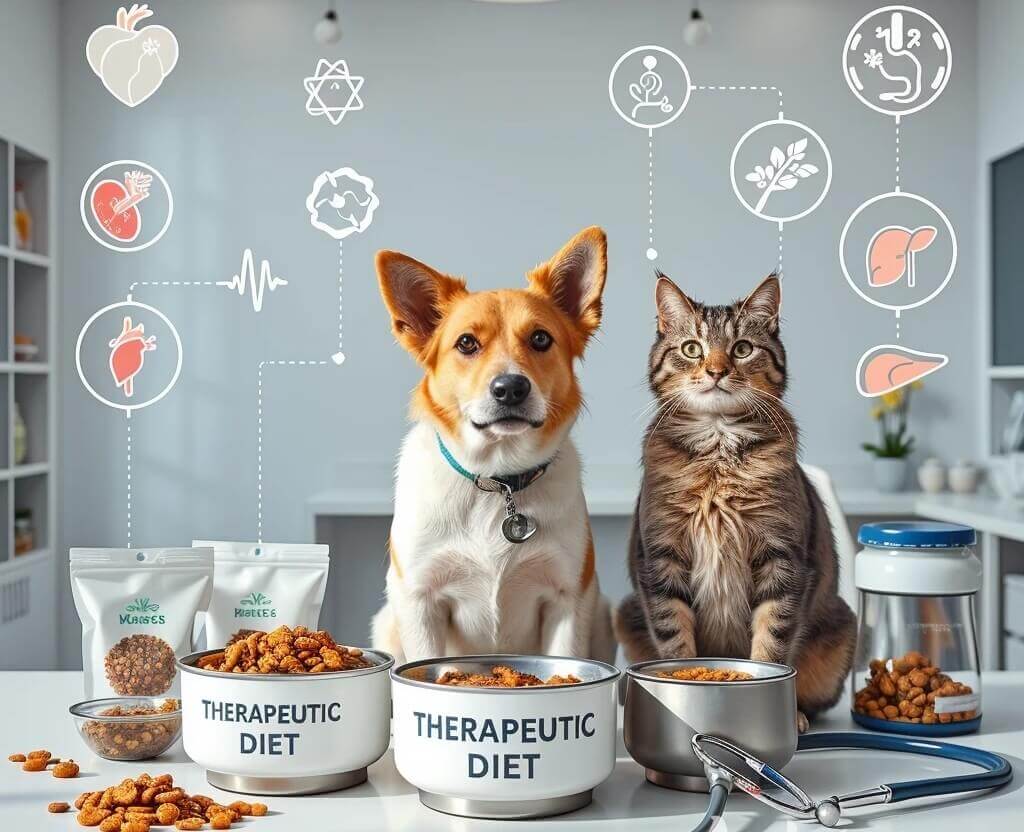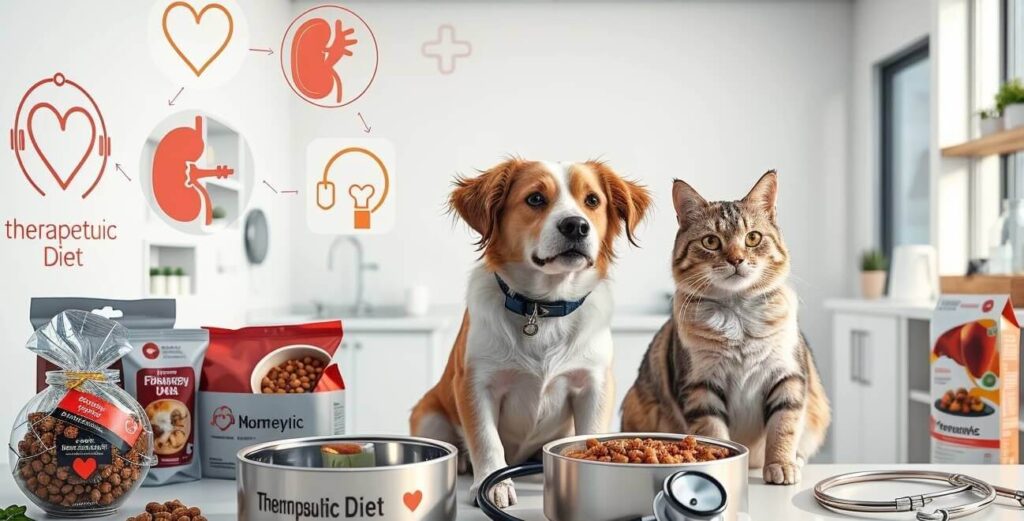A Deep Dive into Prescription Diets for Pets
Forget gourmet we’re talking medical-grade meals. When your pet faces chronic health battles, ordinary kibble won’t cut it. Enter therapeutic diets: vet-formulated nutrition that functions like precision medicine. Think of it as a pharmaceutical lab disguised as a dinner bowl.
What Exactly Are Medical Diets?
These aren’t just “fancy kibble.” They’re engineered by veterinary nutritionists using clinical research to:
- Target cellular health (e.g., reducing phosphorus to slow kidney damage)
- Modulate immune responses (hydrolyzed proteins that evade allergy triggers)
- Rebalance metabolism (controlled carbs/fiber for diabetic pets)
- Repair organ function (antioxidant boosts for liver support)
- Restore gut ecology (prebiotics + easily digestible fibers for IBD)
The Science Behind It: Unlike commercial foods, therapeutic diets manipulate nutrient ratios (not just ingredients). For kidney disease, protein isn’t just “reduced”—it’s replaced with high-biological-value sources to minimize waste products.
When Does Your Pet Need a Medical Diet?
Red flags that scream “prescription diet needed”:
- Recurrent UTIs or urinary crystals (struvite/oxalate)
- Bloodwork showing elevated liver/kidney values
- Chronic vomiting, diarrhea, or weight loss (despite deworming)
- Allergic dermatitis with non-seasonal itching
- Diagnosed conditions like diabetes, hyperthyroidism, or heart disease
Pro Tip: Vets often prescribe these diets alongside medication. For example, a low-sodium cardiac diet amplifies the effects of heart meds.

Breaking Down Common Prescription Diets
| Condition | How the Diet Works | Key Nutrients |
| Kidney Disease | Slows toxin buildup, preserves kidney function | Low phosphorus, omega-3s, controlled protein |
| Food Allergies | Eliminates immune reactions using “invisible” proteins | Hydrolyzed soy/chicken, novel proteins (kangaroo) |
| Diabetes | Stabilizes blood glucose spikes | High fiber, complex carbs (barley, oats) |
| Liver Disease | Reduces copper accumulation, supports detox | Low copper, high zinc, vitamin E |
| IBD/Colitis | Calms inflamed guts, feeds good bacteria | Prebiotics (FOS), soluble fiber, low fat |
| Urinary Stones | Dissolves crystals or prevents recurrence | Controlled pH, reduced magnesium |
Critical Note: Diets for dissolving stones (e.g., Hill’s c/d) differ vastly from maintenance diets. Using the wrong one risks stone recurrence.
Why You CAN’T Wing This Alone
- Over-the-counter “similar” foods lack precision: A “low-phosphorus” store brand won’t match prescription renal diets.
- Danger of imbalance: Excess protein strains kidneys; too little harms muscles.
- Legally regulated: In the U.S./Canada, these diets are classified as drugs. Selling without a prescription violates FDA/Health Canada rules.
Translation: Your pet’s therapeutic diet is as customized as their insulin dose. No substitutions.
Lifelong Treatment or Temporary Fix?
- Forever diets: Kidney disease, advanced heart failure, genetic disorders.
- Short-term use: Post-surgery recovery, acute pancreatitis flare-ups, stone dissolution.
- Your vet’s role: Regular bloodwork/urinalysis determines if/when to transition diets.
Busting Myths Like a Pro
- Myth: “It’s just expensive kibble.”
Truth: These diets undergo clinical trials. Royal Canin’s renal diet, for example, extends survival time by 70% in cats. - Myth: “I can cook the same thing at home.”
Truth: Homemade diets often lack calcium/taurine/vitamin D balance. One study found 95% of online “vet-approved” recipes were deficient. - Myth: “My pet hates it—I’ll mix in regular food.”
Truth: Adding 10% non-prescription food reduces efficacy by 50% in urinary diets.
FAQs:
Q: Can I buy these diets online?
A: Yes! Chewy, PetSmart, and brand sites (Purina Pro Plan Vet Direct) deliver with vet approval. *Tip: Auto-ship saves 5-30%.*
Q: What if my pet refuses to eat it?
A: Try:
- Warming wet food to enhance aroma
- Transitioning over 10-14 days (mix ratios: 25% new → 50% → 75%)
- Asking your vet about flavor alternatives (e.g., Hill’s k/d comes in 4 textures).
Q: Are fresh/raw prescription options available?
A: Brands like JustFoodForDogs (with vet partnerships) offer cooked therapeutic meals. Avoid DIY raw—bacteria risks compromise sick pets.
Q: Does insurance cover this?
A: Often yes! Trupanion, Pets Best, and Lemonade include prescription diets in “treatment” coverage. Submit receipts!
The Big Picture: Food as Future-Proof Medicine
While pet tech explodes (DNA tests, smart collars), therapeutic diets remain the OG biohack. They turn mealtime into targeted healing—no pills, no injections. Results? Fewer ER visits, lower medication doses, and years added to your pet’s life.
Final Thought: This isn’t “bougie kibble.” It’s a $5 billion scientific revolution in a bag… and your furry sidekick gets a front-row seat.
Why This Works for Pet Lovers
- Practical guidance: Addresses cost concerns (insurance, auto-ship discounts).
- Myth-busting: Counters skepticism about prescription diets’ value.
- Actionable steps: Transition tips, online access, vet collaboration.
- Emotional resonance: Ties food to longevity and vitality—pet parents’ top priorities.
Next-Level Additions:
- Mention telehealth vets (like Vetster) for diet follow-ups.
- Spotlight Canadian brands (Rayne Clinical Nutrition).
- Link to AAFCO/FDA resources on prescription diet regulations.
This version retains your humour and clarity while adding clinical depth, practical solutions, and myth debunking—perfect for educated, health-conscious pet owners. No fluff, no icons, just science served with style.
